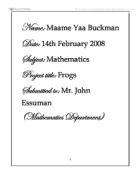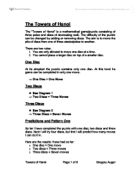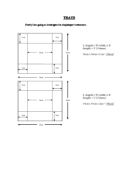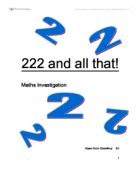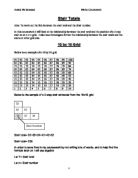Conclusion: Number of hops=1
Number of slides=2
Total number of moves=3
Question 1: Try the same thing this time with 2 discs of each colour.
Step 1
Step 2
Step 3
Step 4
Step 5
Step 6
Step 7
Step 8-
Conclusion: Number of hops=4
Number of slides=4
Total number of moves=8
Question 2: Now try with 3 discs of each colour .Can You complete it in 15 moves ?
Step 1-A3 slides to the right
Step 2-B1 hops to the left
Step 3-B2 slides to the left
Step 4 –A3 hops to the right
Step 5-A2 hops to the right
Step 6-A1 slides to the right
Step 7 –B1 hops to the left
Step 8 –B2 hops to the left
Step 9 –B3 hops to the left
Step 10 –A3 slides to the right
Step 11-A2 hops to the right
Step 12-A1 hops to the right
Step 13 –B2 slides to the left
Step 14- B3 hops to the left
Step 15-A1 slides to the right
Conclusion: Number of hops=9
Number of slides=6
Total number of moves=15
Question 3: Now try four discs of each color and try to get the least number of moves possible.
Step 1-A4 slides to the right
Step 2-B1 hops to the left
Step 3-B2 slides to the right
Step 4-A4 hops to the right
Step 5-A3 hops to the right
Step 6 –A2 slides to the right
Step 7-B1 hops to the left
Step 8-B2 hops to the left
Step 9 –B3 hops to the left as well
Step 10-B4 slides to the left
Step 11-A4 hops to the right
Step 12-A3 hops to the right
Step 13-A2 hops to the right
Step 14-A1 hops to the right
Step 15 –B1 slides to the left
Step 16 –B2 hops to the left
Step 17 –B3 hops to the left
Step 18 –B4 hops to the left
Step 19 –A3 slides to the right
Step 20-A2 hops to the right
Step 21-A1 hops to the right
Step 22-B3 slides to the left
Step 23-B4 Hops to the left
Step 24-A1 slides to the right
Conclusion: Number of hops=16
Number of slides=8
Total number of moves=24
Now look at your results and try to find a formula which gives the least number of moves needed for any number of discs x .It may help if you can count the number of “hops” and “slides” separately .
Therefore to find the number of moves you can apply this formula :
Question 4: Try the game with a different number of discs on each side . Say 1 green and 2 blues
Step 1-A slides to the right
Step 2-B1 hops to the left
Step 3-A slides to the right
Step 4 –B2 hops to the left
Step 5-A slides to the left
Conclusion: Number of hops =2
Number of slides=3
Total number of moves =5
Question 5: Try this with 2 greens and 3 blues .
Step 1-A2 slides to the right
Step 2-B1 hops to the left
Step 3-B2 slides to the left
Step 4-A2 hops to the right
Step 5-A1 hops to the right
Step 6-B1 slides to the left
Step 7-B2 hops to the left
Step 8-B3 hops to the left
Step 9 –A2 slides to the right
Step 10 –A1 hops to the right
Step 11-B3 slides to the left
Conclusion: Number of hops=6
Number of slides=5
Total number of moves=11
Question 6: Try this for 3 green and four blues .
Step 1-A3 slides to the right
Step 2 –B1 hops to the left
Step 3-B2 slides to the left
Step 4-A3 hops to the right
Step 5-A2 hops to the right
Step 6-A1 slides to the right
Step 7 –B1 hops to the left
Step 8- B2 hops to the left
Step 9-B3Hops to the left
Step 10 –B4 slides to the left
Step 11-A3 hops to the right
Step 12-A2 hops to the right
Step 13-A1 hops to the right
Step 14-B2 slides to the left
Step 15-B3 hops to the left
Step 16 –B4 hops to the left
Step 17-A2 slides to the right
Step 18 –A1 hops to the right
Step 19 –B4 slides to the left
Conclusion: Number of hops=12
Number of slides=7
Total number of moves=19
Question 7 : Try this with 4 green and 5 blues
Step 1-A4 slides to the right
Step 2-B1 hops to the left
Step 3-A3 slides to the right
Step 4-1 hops to the left
Step 5-B2 hops to the left
Step 6-B3 slides to the left
Step 7-A4 hops to the right
Step 8- A3 hops to the right
Step 9-A2 hops to the right
Step 10-A1 slides to the right
Step 11-B1 hops to the left
Step 12-B2 hops to the left
Step 13- B3 Hops to the left
Step 14-B4 hops to the left
Step 15-B5 slides to the left
Step 16 –A4 hops to the right
Step 17-A3 hops to the right
Step 18 –A2 Hops to the right
Step 19 – A1 hops to the right
Step 20 –B2 slides to the left
Step 21-B3 hops to the left
Step 22-B4 hops to the left
Step 23 –B5 hops to the left
Step 24-A3 slides to the right
Step 25-A2 hops to the right
Step 26 –A1 hops to the right
Step 27 –B4 slides to the left
Step 28-B5 hops to the left
Step 29- A1 slides to the right
Conclusion: Number of hops=20
Number of slides=9
Total number of moves=29
After you have played the game with different combinations and again try to find a formula giving the number of moves for “x” discs of one colour and “y” discs of another colour.
- Let X represent one colour
- And Y Represent another colour.
Use the formula below to calculate the number of moves as well as the number of slides and hops.
Let us try this formula given 4 greens and 5 blues
4×5+ (4+5)
Therefore, 20+9 where 20 = number of hops.
9=number of slides.
20 +9 =29 (this is the total number of moves.)
Conclusion
At the end of this interesting game you gain a lot of intuitive about how to obtain a formula from a random game .It also teaches you how to look at patterns .If such skills are obtained it can be applied to ones daily life.



